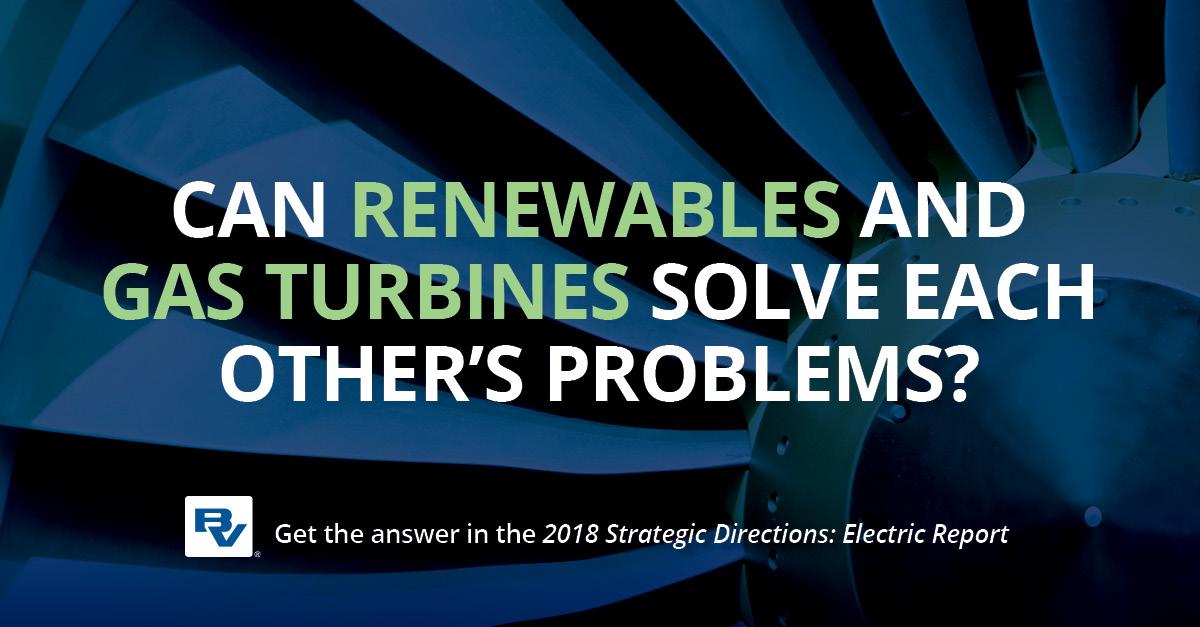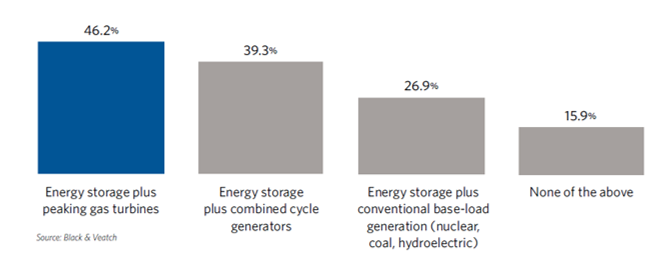Energy Storage Proves Key to Delivering Natural Gas Advantages
New scenarios are emerging that pair storage with conventional gas turbine generation
The cost of energy storage has fallen to the point where the power generation industry is moving from demonstration projects to full deployment. Driven by demand and a federal order designed to nurture broader adoption of storage capabilities, practical applications of energy storage are emerging that are competitive with conventional solutions.
In addition, continued annual reductions in the cost for storage will reveal more and more applications where energy storage makes economic sense. A great example can be found in the performance optimization of gas turbines.
In recently establishing Order 841 to integrate energy storage into the power market, FERC declared the order would “enhance competition and promote greater efficiency in the nation’s electric wholesale markets, and will help support the resilience of the bulk power system.” While many initially ascribed storage’s primary value to the capture of renewable energy and subsequent grid resilience, new scenarios are emerging that pair storage with conventional gas turbine generation to deliver more rapid response, milder ramp rates, fewer starts and stops, and emissions reductions.
In a way, gas turbines and renewables are beginning to solve each other’s problems.
Gas turbines have long played a central role in helping supply meet demand, given their ability to quickly flex up or down to demand peaks and dips. But their efficiency is diminished when running under or above optimal load. Meanwhile, the rise of renewable energy sources promises to reduce our carbon footprint, but they also carry hazards for utility managers because their
variability and intermittency complicate loadbalancing and grid-planning efforts.
Enter the battery storage-augmented gas turbine, in which storage performs as a kind of reserve that springs to life to smooth and optimize turbine performance levels.
ENERGY STORAGE GAINS MOMENTUM
Southern California Edison and General Electric recently retrofitted a 50 megawatt (MW) gas turbine with a 10 MW lithium-ion battery energy storage system (BESS). The system now has faster response, both starting and ramping. In 2017, American Electric Power and the Finnish company Wärtsilä added a 4 MW BESS to a hydroelectric plant. New revenues are generated with the faster response in the PJM market for two forms of ancillary services, having closed the gap for responsiveness to command signals.
In 2018, AES Corporation won a power purchase agreement (PPA) tender from Southern California Edison for 1,284 MW of combined cycle capacity with 100 MW of BESS capacity. Greater performance from the system allowed lower PPA prices. The combined cycle plant is expected to come online in 2020, with the BESS to follow in 2021. Projected reductions in capital
costs for the BESS enabled this success.
Black & Veatch recently worked with a client and a power electronics supplier to design and build a 4 MW BESS, retrofitting it to the client’s existing multi-megawatt solar photovoltaic facility. Energy storage is a common element of Black & Veatch work in distributed generation, particularly in microgrids. Other companies who have announced storage plus conventional generation include NextEra Energy, Southern Company, Siemens and Aggreko, among others.
ENERGY STORAGE BENEFITS
Benefits can be accrued by design for new builds and for repowering builds, as well as by retrofitting an operating asset with some
form of storage technology. For the foreseeable future, lithium-ion BESS will provide the lowest capital cost option. Other battery technologies such as “flow batteries” store more energy for longer durations than lithium-ion with little or no capacity degradation. Other storage technologies such as mechanical flywheels and supercapacitors can also improve conventional generation technology operation. Direct, revenue-based benefits can be accrued in locations where the energy market has established requirements that embrace the performance attributes of energy storage.
Energy storage projects can be rate-based in states where the public utility commission has decided to allow that, typically on a project-byproject basis. Indirect benefits of many kinds can be accrued because of the flexible operating envelope of lithium-ion BESS. Intangible benefits become relevant when they are important to the stakeholders for a project (Table 1).
The market appears to be embracing storage-turbine projects. Energy storage plus peaking gas turbines are seen as the most likely pairing in the next two to three years, followed by energy storage plus combined-cycle units, according to survey respondents (Figure 1).
Energy storage options tied to gas turbines provide key advantages across a range of potential deployments:
- Option 1 - Starting and ancillary services: A BESS rated for 10 MW could substitute for a static frequency converter that brings the combustion turbine (CT) unit up to crank speed until the unit starts. When not in use, the BESS can participate in ancillary services markets, providing power quality services and accruing revenue as the local energy markets allow. If additional energy storage duration is added, the BESS can absorb operational high-ramp-rate demands, reducing wear and tear and lowering operating and maintenance costs.
- Option 2 - Spinning reserve and ramp mitigation: When not called to operate for the CT, the BESS can participate to a greater extent in ancillary services markets, providing power quality services and accruing revenue as the local energy markets allow. Additionally, the BESS can absorb operational high-ramp-rate demands.
- Option 3 - CT life extension: An optimally sized BESS with a MW capacity between the first two options would have an energy storage duration of one to four hours. Such storage would be designed to be sufficient to avoid turbine operation when short-duration run times are forecast for the CT. The reduction in the number of starts/stops of the turbine can translate to a longer operating life (years), reduced operations and maintenance and reduced emissions. The BESS would also protect the unit from starts that would need very short run times, also extending the calendar life of the unit.
FROM DEMONSTRATION TO DEPLOYMENT
Energy storage is inexpensive, and the age of demonstration projects is over. Practical applications of energy storage have emerged
that are competitive with conventional solutions. Continued annual reductions in the cost forstorage will reveal more and more applications where energy storage makes economic sense.




